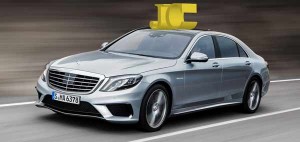Being wealthy can be difficult. Perhaps no one knows that more than job creators, the men and women who supervise people who supervise other people who run companies. Their morning and evening commutes can be brutal. Even with a driver, phone, beverage, and suite of printed and electronic reading material, sitting in traffic has to be irritating for someone as important as a job creator.
The California Department of Transportation and two Silicon Valley counties want to make commutes less traumatic for job creators. Beginning next month, in San Mateo County and Santa Clara County new lane usage will be mandated on Highways 101, 92, 85, 237, and 1, and also Interstates 280, 380, 680, and 880. Only job creators will be allowed to use these lanes. Additionally, lanes on El Camino Real from Sunnyvale to Burlingame’s southern border and from Millbrae through Daly City will be designated for the exclusive use of job creators.
The job creator lanes grew out of an economic analysis of potential improvements to the state’s highway system. A panel of economists scored six different proposals based on how much they would increase economic production in the state. The job creator lanes stood out. The average job creator’s time is worth 17,000 times as much as the average worker’s, so an approach that helps only a few job creators turns out to be more valuable to the economy than one that helps thousands of normal folk. “All men may be created equal, but job creators do a lot more for the economy,” says Hernando Bosch, one of the authors of the study.
Job Creator Lanes will be located in the leftmost portion of roadways. Depending on the road, these lanes will either shift carpool lanes rightward or eliminate them entirely. “We didn’t want to have to wait for the roads to be widened,” says Cal DOT’s Heinrich Febricci. “These job creators should receive this much-deserved benefit sooner, not later. And frankly, the economy needs this boost sooner, not later.”
Regular people who use the lanes will be fined $1,500 for a first offense, and their vehicle will be impounded. Further, they will be charged $100 an hour for every hour the vehicle is held. A regular person caught a second time using a Job Creator Lane faces up to a year of jail time, a fine ranging from $3,000 to $10,000, and vehicle seizure. Fines will be scaled inversely to offenders’ incomes. The lower the person’s income and ability to pay, the higher the fine will be. All fines and fees will go to support an annual summer picnic for job creators, along with an ongoing public awareness program that will relentlessly inform regular people of the contributions job creators make to society. A third violation is considered a capital offense.
Some job creators think this doesn’t go far enough. Winston Beedlekrump is the CEO of Creekside Plastics & Combustibles, a manufacturing company located in Millbrae, California (San Mateo County). He says, “Unless they make it a mandatory death penalty charging, that bleeding heart Kamala Harris, as the A[ttorney] G[eneral], will make sure these jerkoffs don’t get the needle. She’ll lean on the D[istrict] A[ttorney]s, and the bums will sit in some cushy prison for the rest of their lives, watching cable TV I pay for with the $44 of income tax I have to hand over every year. Thank God my company doesn’t pay income tax.”
Beedlekrump adds, “Don’t get me wrong, the highway lanes are a good start, but the people in the other lanes can still look in at you. If these counties really want to make themselves a global capital for job creation, they’ll take up a plan I’ve floated several times to build an elevated roadway just for us. We wouldn’t be limited by existing entrances and exits. We could have a lane that takes you right to Carnival North, or Madera. If they’d really look at my plan, I think it’d blow their minds.”
Sheriff’s deputies, police, and highway patrol officers will be issued readers that register whether or not a vehicle is owned by a job creator. Because it would be an affront to ask job creators to affix government-issued stickers to their vehicles, transmitters will be put in their cars and trucks that will project a hologram with the letters JC visible in bright, golden light.
The process to apply to be recognized as a job creator is straightforward, according to Cal DOT’s Febricci. “Everyone who counts already knows the governor.”
 The determining factor as to whether someone is classified as a job creator isn’t, interestingly enough, the number of jobs a person creates. The measure is a person’s net worth. Febricci explains: “Because job creation is good, and because a person’s level of wealth is the most reliable indicator of inherent goodness, this method makes the most sense. Basically, if your net worth is greater than 100 million dollars, you’re considered a job creator, and you’ll receive this benefit. Some of these people got rich and stay rich by cutting jobs or shipping them elsewhere, so actual ‘job creation’ is not the most useful measure.” The benefits also extend to job creators’ spouses, children and stepchildren of legal driving age, and domestic employees who chauffeur the family around using the family’s vehicles.
The determining factor as to whether someone is classified as a job creator isn’t, interestingly enough, the number of jobs a person creates. The measure is a person’s net worth. Febricci explains: “Because job creation is good, and because a person’s level of wealth is the most reliable indicator of inherent goodness, this method makes the most sense. Basically, if your net worth is greater than 100 million dollars, you’re considered a job creator, and you’ll receive this benefit. Some of these people got rich and stay rich by cutting jobs or shipping them elsewhere, so actual ‘job creation’ is not the most useful measure.” The benefits also extend to job creators’ spouses, children and stepchildren of legal driving age, and domestic employees who chauffeur the family around using the family’s vehicles.
The head of the Valley of the Silicons Chamber of Commerce sees the lanes as a mixed blessing. Chamber president Steve Perturbernot says, “Of course I’m in favor of anything that aids job creators. But what about small business owners? I guess I could be convinced that their not being rich enough makes them less deserving. I just wish more businesspeople could be allowed to participate in this excellent idea.”
Environmentalists and clean-air advocates oppose the plan. They say its elimination or impeding of carpool lanes poses problems. Febricci brushes aside their concerns. “Job creators are a heck of a lot more important than the environment and the penny-pinching carpoolers who are so infatuated with it,” he says. “And let’s not forget, people can still carpool. We’re not outlawing it or anything,” he says. “In fact they’ll have to, since gas is so expensive and median income keeps going down.”
Beedlekrump couldn’t agree more. “It’s good to see the government do something right for a change.”
Electrician Ed Bempter, of Fremont, California (Santa Clara County), thinks it’s a bad idea. “I’m on the road all the time. Don’t these super rich people already have enough advantages? Do they really need more?”
Talmudichter A. Jones, a professor of traffic awareness at Ball State University, in Indiana, says he’s studying the situation closely. “This could prove interesting, beyond northern California,” he says. “I hearken back to the Roman roads built in the second century, which were such improvements in their day, but later provided the means for the Goths and Vandals to strike at the heart of the empire. You never know what will come of traffic measures.”
Mega-billionaire Walter Smorgasboard, of Omaha Nebraska, has learned of the plan and says he opposes it. “Wealthy people should be doing more to help America, not harm it. And this is definitely harmful.” He adds that in his view wealthy people who support such high-visibility privileges are thinking too short-term. “Sitting in traffic and watching you zoom by is going to make that ‘average Joe’ blame you. Then he’s just one step away from grabbing a pitchfork in his hairy hand and coming after you. Sure, your car has the bullet-proof security package, but Mr. Joe will certainly scratch the paint. I tell my friends, you don’t want to live in a world like that.”
Febricci doesn’t think the controversy will amount to much. “We have 2.6 million people living in San Mateo and Santa Clara Counties. You’re bound to have a few bad apples who complain every time there’s progress.”
Applications to be classified as a job creator living in, working in, or commuting through either of the two counties will be accepted beginning next Tuesday.
More developments out of the Bay Area:
Utility Executive Demonstrates How Average People Will Suffer if His Company Is Fined
More about wealth in America:
New Business Helps Wealthy Hold Onto Self-Importance in Modern World


